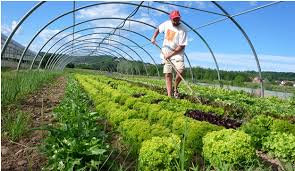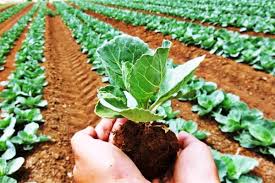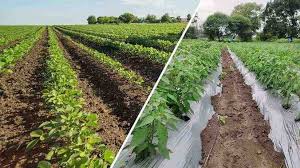Organic farming works in harmony with nature rather than against it. This involves using techniques to achieve good crop yields without harming the natural environment or the people who live and work in it.
The methods and materials used in organic farming are designed to
- maintain and build good soil structure and fertility
- control pests, diseases, and weeds, and
- use water resources carefully while practicing good animal husbandry**.
Organic farming does not mean returning to old traditional methods alone. Many past farming practices remain useful today.
Organic farming combines these traditional practices with modern scientific knowledge. Farmers do not leave their farms to be overtaken by nature; they apply all available knowledge, techniques, and materials to work alongside nature.
This creates a healthy balance where crops and animals can grow and thrive.
Success in organic farming depends on understanding that not every insect is a pest, not every plant out of place is a weed, and not every problem requires artificial chemical sprays. The goal is to control pests and weeds to an acceptable level while benefiting from their presence when possible.
Read Also: Cutworms: How to Identify and Get Rid of Cutworms
Weed Control Methods in Organic Farming Systems

Weeds are often regarded as the most significant challenge in organic farming systems and are a major concern for farmers transitioning from conventional to organic methods. The objective is not to eliminate weeds completely but to manage them effectively.
Weed control involves reducing the impact of weeds on crop growth and yield. Organic farming avoids herbicides, which, like pesticides, leave harmful residues and may destroy beneficial plants that support useful insects. Weed control methods in organic farming include:
- Crop rotation to disrupt weed growth cycles
- Hoeing to physically remove weeds
- Mulching to cover soil and prevent weed seed germination
- Hand-weeding or mechanical weeders to remove weeds
- Planting crops closely to limit space available for weeds
- Using green manures or cover crops to outcompete weeds
- Repeated soil cultivation at the right time to reduce weeds without causing erosion
- Employing animals to graze on weeds
Weeds also serve useful purposes, such as preventing soil erosion, providing food for animals and beneficial insects, and sometimes offering food for humans.
Natural Pest and Disease Control Strategies in Organic Farming
Pests and diseases naturally occur in agricultural ecosystems. Ideally, a balance exists between pests and their predators. When this balance is disrupted, pest populations may dominate.
The goal of natural pest control is to restore this balance and maintain pests and diseases at manageable levels rather than eradicate them entirely.
Organic farmers can control pests and diseases using natural methods such as:
- Growing healthy crops that are less vulnerable to damage
- Choosing crop varieties with natural resistance, especially local varieties adapted to local pests and diseases
- Timing planting to avoid peak pest activity periods
- Companion planting with crops pests avoid, like onions or garlic
- Trapping or hand-picking pests
- Accurate identification of pests and diseases
- Crop rotation to break pest cycles and prevent pest carryover
- Creating habitats to encourage natural predators of pests
Proper planning and these techniques usually eliminate the need for chemical sprays. If necessary, natural pesticides derived from chilli, onion, garlic, or neem may be used, but their use should be minimal and comply with national and international organic standards.
Read Also: 15 Medicinal Health Benefits of Ficus Deltoidea (Misletoea Fig)
Genetic Diversity and Its Importance in Organic Crop Production

Genetic differences within a crop population affect characteristics such as height and disease resistance. Traditional crop varieties contain greater genetic diversity than modern bred crops, as they have been selected over centuries to meet local farming needs.
Modern bred crops tend to be uniform, which can increase vulnerability to pests and diseases. Some modern varieties may be resistant to specific problems but often are less suited to local environmental conditions. Relying heavily on a single modern variety can be risky.
In organic farming, genetic diversity within crops is beneficial. Growing a variety of crops reduces the risk of pest outbreaks and crop failure during adverse weather conditions like drought or flood. Organic farmers should:
- Grow mixed crops in the same field (mixed cropping, intercropping, strip cropping)
- Plant different varieties of the same crop
- Use local crop varieties whenever possible
- Save seeds from local and improved varieties rather than depending solely on external seed sources
Water Conservation and Animal Husbandry Practices in Organic Farming
1. Careful Use of Water in Organic Agriculture
Water management is critical, especially in arid regions. Organic farming emphasizes using locally available water sustainably to avoid depletion. Techniques for conserving water include:
i. Constructing terraces, rainwater basins, or catchments to capture rainfall
ii. Adding organic matter to soil to enhance water retention
iii. Applying mulches to conserve soil moisture and prevent surface drying
2. Animal Husbandry in Organic Farming
Animal welfare is a priority in organic farming. Animals must have sufficient space to express natural behaviors such as standing and moving freely. However, it is important to manage animals carefully to prevent crop damage.
Organic feed should be provided, and livestock breeds should be selected based on local environmental conditions and resource availability. These practices promote healthier animals that are more resistant to disease and more productive.
International Organic Farming Standards and Their Role
The International Federation of Organic Agriculture Movements (IFOAM) has established global organic standards developed by experts worldwide. These standards guide organic farming practices and help countries develop their own regulations.
National organic certification authorities assess farms and award certification symbols to those meeting standards. Certified organic produce carries this symbol, assuring consumers of its authenticity.
IFOAM’s main principles for organic farming include:
- Producing high-quality food in adequate quantities
- Enhancing natural biological cycles involving microorganisms, soil organisms, plants, and animals
- Maintaining and improving long-term soil fertility
- Using renewable resources and minimizing external inputs
- Recycling materials within or outside the farm system
- Providing livestock with living conditions that support natural behaviors
- Minimizing pollution from agricultural activities
- Preserving genetic diversity and protecting wildlife habitats
- Supporting farmers’ livelihoods with fair returns and safe working environments
- Considering social and ecological impacts of farming systems
Organic food demand is increasing in regions like Europe and America. To market food as organic, certification through recognized organizations is required, which involves a rigorous and sometimes costly process.
This article outlined how weeds impact crop growth and yield, making them a primary concern in organic farming. Organic systems avoid herbicides to prevent environmental residues.
Pests and diseases are natural components managed by restoring predator-pest balance, not eradication. Genetic diversity within crops is beneficial, protecting against pests and crop failures caused by extreme weather.
Water conservation is crucial, especially in arid regions, requiring judicious use of local water resources. Animal welfare is central in organic farming, with attention to natural behavior and suitable breeds.
Finally, international organic standards by IFOAM provide essential guidelines to ensure that farming practices meet global criteria. Certification helps farmers market genuine organic products, meeting growing consumer demand.
Do you have any questions, suggestions, or contributions? If so, please feel free to use the comment box below to share your thoughts. We also encourage you to kindly share this information with others who might benefit from it. Since we can’t reach everyone at once, we truly appreciate your help in spreading the word. Thank you so much for your support and for sharing!

